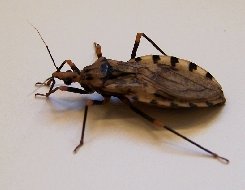
Triatoma protracta is a species of bugs in the family Reduviidae. It is known commonly as the western bloodsucking conenose. It is distributed in the western United States and Mexico.

Carlos Justiniano Ribeiro Chagas, or Carlos Chagas, was a Brazilian sanitary physician, scientist, and bacteriologist who worked as a clinician and researcher. He discovered Chagas disease, also called American trypanosomiasis, in 1909, while he was working at the Oswaldo Cruz Institute in Rio de Janeiro.
Protozoology is the study of protozoa, the "animal-like" protists. The Protozoa are considered to be a subkingdom of Protista. They are free-living organisms that are found in almost every habitat. All humans have protozoan found living on their body, and many people may be infected with one or more throughout their life.

The members of the Triatominae, a subfamily of the Reduviidae, are also known as conenose bugs, kissing bugs, or vampire bugs. Other local names for them used in The Americas include barbeiros, vinchucas, pitos, chipos and chinches. Most of the 130 or more species of this subfamily feed on vertebrate blood; a very few species feed on invertebrates. They are mainly found and widespread in the Americas, with a few species present in Asia and Africa. These bugs usually share shelter with nesting vertebrates, from which they suck blood. In areas where Chagas disease occurs, all triatomine species are potential vectors of the Chagas disease parasite Trypanosoma cruzi, but only those species that are well adapted to living with humans are considered important vectors. Also, proteins released from their bites have been known to induce anaphylaxis in sensitive and sensitized individuals.

Triatoma is a genus of assassin bug in the subfamily Triatominae. The members of Triatoma are blood-sucking insects that can transmit serious diseases, such as Chagas disease. Their saliva may also trigger allergic reactions in sensitive individuals, up to and including severe anaphylactic shock.

Rhodnius is a genus of assassin bugs in the subfamily Triatominae, and is an important vector in the spread of Chagas disease. The Rhodnius species were important models for Sir Vincent Wigglesworth's studies of insect physiology, specifically growth and development.

The black-headed night monkey is a night monkey species from South America. It is found in Brazil, Bolivia and Peru. The A. nigriceps in Peru were notably inhabiting areas that were degraded, and often these areas were disturbed either by human activities or natural occurrences in the ecosystem.

Panstrogylus geniculatus is a blood-sucking sylvatic insect noted as a putative vector of minor importance in the transmission of Trypanosoma cruzi to humans; this is a parasite, which causes Chagas disease. The insect is described as sylvatic; subsisting primarily in humid forests, and is also known to inhabit vertebrate nesting places such as those of the armadillo, and is also involved in enzootic transmission of T. cruzi to those species. It has wide distribution throughout 16 Latin American countries.
The tribe Alberproseniini Martínez & Carcavallo, 1977 belongs to the subfamily Triatominae and only has one genus, Alberprosenia Martínez & Carcavallo, 1977, with two species:

Thyrsodium is a genus of plants in the family Anacardiaceae.

Triatoma brasiliensis is now considered the most important Chagas disease vector in the semiarid areas of northeastern Brazil. T. brasiliensis occurs in 12 Brazilian states, including Maranhão, Piauí, Ceará, Rio Grande do Norte, and Paraíba.
Triatoma juazeirensis is an assassin bug, a Chagas disease vector which occurs in the State of Bahia, Brazil. It is found in natural and artificial environments infesting mainly the peridomiciliary areas but it may also colonize the intradomicile. T. juazeirensis can be distinguished from the other members of the brasiliensis complex by its entire dark pronotum and legs.

Triatoma rubrovaria is an insect which is ubiquitous in Uruguay, in neighboring parts of northeastern Argentina, and in the southern states of Paraná and Rio Grande do Sul in Brazil. This species of triatomine is found mainly among exfoliate rocks known as pedregales. It was earlier reported as T. (triatoma) rubrovaria, a sylvatic species inhabiting rock piles, rarely found in human dwellings. This species may be a highly competent vector of Trypanosoma cruzi, the causative agent of Chagas disease. In Rio Grande do Sul, data from the Chagas disease Control Program have indicated an increasing of domiciliary and peridomiciliary invasion of T. rubrovaria, where it has become the most frequently triatomine species captured in that State since the control of T. infestans.
Trypanosoma rangeli is a species of hemoflagellate excavate parasites of the genus Trypanosoma. Although infecting a variety of mammalian species in a wide geographical area in Central and South America, this parasite is considered non-pathogenic to these hosts. T. rangeli is transmitted by bite of infected triatomine bugs of the Reduviidae family, commonly known as barbeiro, winchuka(vinchuca), chinche, pito ou chupão.

Biomphalaria tenagophila is a species of air-breathing freshwater snail, an aquatic pulmonate gastropod mollusk in the family Planorbidae, the ram's horn snails.
Elaeoluma is a genus of plants in the family Sapotaceae described as a genus in 1891.

Panstrongylus megistus is a blood-drinking insect in the subfamily Triatominae. It is found in the Guianas, Brazil, Bolivia, Paraguay, Uruguay and Argentina, and is an important vector of Trypanosoma cruzi, particularly in Brazil. Besides humans, P. megistus is known to feed on birds, rodents, horses, dogs, opossums and bats.
Anopheles bellator is a species of mosquito mainly located in southeast of State of São Paulo, Brazil, is a main vector of malaria.

Triatoma sordida is an assassin bug within the genus Triatoma. This species consists of three subspecies. Also referred to as kissing bugs, T.sordida are most well known for their role as a secondary vector of Chagas Disease. Inhabiting warm, dry climates, T.sordida are widely distributed throughout South America, occupying houses, farming structures, and wild habitats. Pest control is currently focused on insecticide application. However, biological controls utilizing fungi appear promising.













